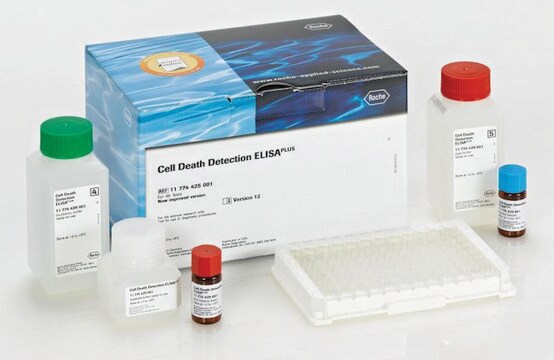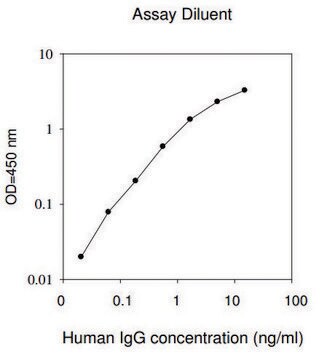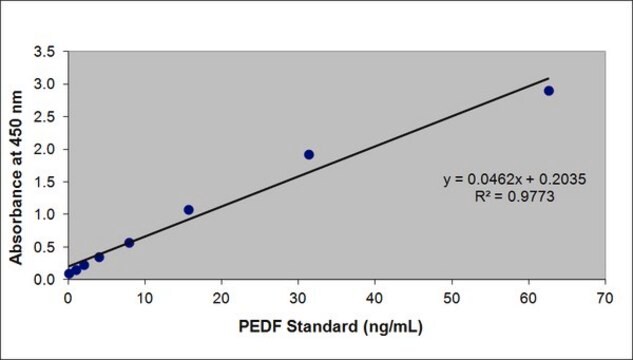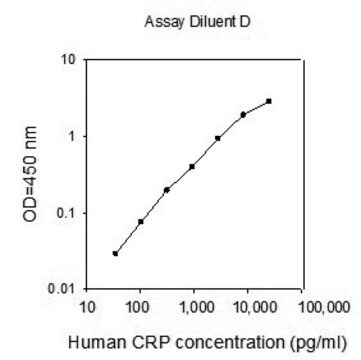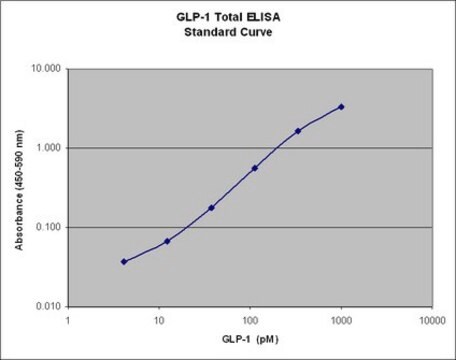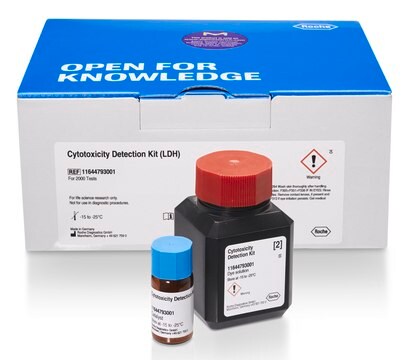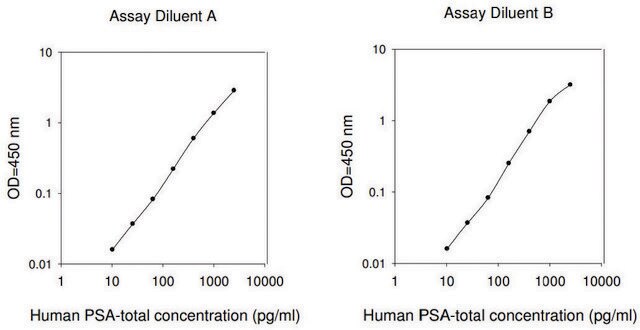11585878001
Roche
hGH ELISA
sufficient for 192 tests, >98% (SDS-PAGE), kit of 1, suitable for ELISA
Sinonimo/i:
ELISA
Autenticatiper visualizzare i prezzi riservati alla tua organizzazione & contrattuali
About This Item
Codice UNSPSC:
41116158
Prodotti consigliati
Saggio
>98% (SDS-PAGE)
impiego
sufficient for 192 tests
Confezionamento
kit of 1
Produttore/marchio commerciale
Roche
tecniche
ELISA: suitable
Temperatura di conservazione
2-8°C
Descrizione generale
Human growth hormone (hGH) is specifically detected by the hGH ELISA. It does not cross-react with rat growth hormone. Cross-reactivity with the human homologues TSH, FSH, and LH has not been tested. The hGH protein from E. coli, included in the kit for the purpose of compiling a standard calibration curve, is provided with lot-specific content data as determined by immunoassay.
hGH Standards
The hGH protein from E. coli, included in the kit for the purpose of compiling a standard calibration curve, is provided with lot-specific content data as determined by immunoassay.
hGH Standards
The hGH protein from E. coli, included in the kit for the purpose of compiling a standard calibration curve, is provided with lot-specific content data as determined by immunoassay.
The hGH assay system differs from most of the other commonly used reporter proteins (CAT, β-Gal, or luciferase) in one important respect: hGH is a secreted protein, and is measured using samples of culture-medium supernatants thus (i) avoiding the necessity to lyse cells, (ii) allowing continuous monitoring of transient expression kinetics, and (iii) allowing use of the cells for other purposes (e.g., RNA isolation). Additionally, hGH is a mammalian gene that may contribute to the apparent high stability of the hGH mRNA in most mammalian cells.
Using the standard isotopic protocol, secretion of hGH protein into the culture-medium supernatant can be monitored approximately 24hours post-transfection, depending on the cell type and the sensitivity of the assay used. Usually, hGH is quantified by an immunoradiometric assay (IRMA), resulting in a linear range of approximately 0.1 to 50ng hGH/ml.
Using the standard isotopic protocol, secretion of hGH protein into the culture-medium supernatant can be monitored approximately 24hours post-transfection, depending on the cell type and the sensitivity of the assay used. Usually, hGH is quantified by an immunoradiometric assay (IRMA), resulting in a linear range of approximately 0.1 to 50ng hGH/ml.
Specificità
The hGH ELISA specifically detecs human growth hormone (hGH). It does not cross-react with rat growth hormone.
Applicazioni
For research use only. Not for use in diagnostic procedures.
The hGH ELISA is used to quantitatively measure the expression level of hGH released into cell culture supernatant of eukaryotic cells transfected with a plasmid containing a reporter gene that encodes for hGH.
The hGH ELISA is used to quantitatively measure the expression level of hGH released into cell culture supernatant of eukaryotic cells transfected with a plasmid containing a reporter gene that encodes for hGH.
Caratteristiche e vantaggi
- Standardized: Allows direct comparison of data from different sets of experiments, even when kits from different production lots are used
- More sensitive: The hGH ELISA is approximately 20-times more sensitive than isotopic hGH assays
- More specific: The hGH ELISA shows no crossreactivity with rat growth hormone
- Faster: Measures hGH expression as early as 18hours post-transfection and requires only approximately 4 hours from start to finish
- Easy to perform: Follows a standard ELISA protocol
Confezionamento
1 kit containing 9 components.
Specifiche
Assay time: Approximately 4 hours
Sample material: Culture supernatant
Sensitivity: ≥5pg/ml (≥1pg/well)
Standards: The hGH protein from E. coli, included in the kit for the purpose of compiling a standard calibration curve, is provided with lot-specific content data as determined by immunoassay.
Sample material: Culture supernatant
Sensitivity: ≥5pg/ml (≥1pg/well)
Standards: The hGH protein from E. coli, included in the kit for the purpose of compiling a standard calibration curve, is provided with lot-specific content data as determined by immunoassay.
Principio
The hGH ELISA is based on the sandwich ELISA principle. Antibodies to hGH (anti-hGH) are prebound to the surface of the microplate. The culture supernatant, which contains secreted hGH, is added to the wells of the microplate modules. All hGH contained in the medium binds to the anti-hGH bound to the microplate surface. Next, a digoxigenin-labeled antibody to hGH (anti-hGH-DIG) is added, then bound to hGH. In the following step, an antibody to digoxigenin conjugated to peroxidase (anti-DIG-POD) is added, then bound to digoxigenin. In the final step, the peroxidase substrate ABTS is added. The peroxidase enzyme catalyzes the cleavage of the substrate, yielding a colored reaction product. The absorbance of the sample is determined using an ELISA reader, and is directly correlated to the level of hGH present in the medium supernatant. The sensitivity of the assay can be enhanced using the peroxidase substrate (ABTS) with substrate enhancer.
Nota sulla preparazione
Working solution: Solution 1 hGH Stock Solution (bottle 1)
Reconstitute the lyophilizate in 0.5 ml double distilled water. The resulting concentration is calculated using the lot-specific information, given on the label (final conc. approx 10 ng/ml). This solution is used for the preparation of hGH standards for establishing a hGH calibration curve (see 7.2: preparation of hGH standards).
Solution 2 Anti-hGH-DIG (bottle 2)
Reconstitute the lyophilizate in 0.5 ml double distilled water (final conc. 100 μg/ml).
Solution 2a Anti-hGH-DIG, working dilution
To prepare anti-hGH-DIG working dilution, dilute the reconstituted anti-hGH-DIG solution (100 g/ml) with sample buffer (solution 7) to a final conc. of 1 μg/ml (e.g., 100 μl of reconstituted anti-hGH-DIG solution 9.9 ml of solution 7 for 50 wells).The working dilution should be prepared freshly before use and should not be stored.
Solution 3 Anti-DIG-POD (bottle 3)
Reconstitute the lyophilizate in 0.5 ml double distilledwater (final conc. 20 U/ml). Do not add sodiumazide!
Solution 3a Anti-DIG-POD, working dilution
To prepare anti-DIG-POD, working dilution, dilute the reconstituted anti-DIG-POD solution (20 U/ml) with sample buffer (solution 7) to a final conc. of 200 mU/ml (e.g., 100 μl of reconstituted anti-DIG-POD solution 9.9 ml of solution 7 for 50 wells). The working dilution should be prepared freshly before use and should not be stored.
Solution 4 POD Substrate (bottle 4)
Ready-to-use solution.
Solution 5 POD Substrate containing Substrate Enhancer (bottles 4 and 5)
If a low hGH concentration in the sample is expected, add 1 mg of substrate enhancer (bottle 5) per ml of solution 4 and mix by stirring for 30 min at 15 to 25 °C. The solution is stable for only 2 hours and should therefore be prepared immediately before use. Use the substrate enhancer only if the hGH concentration is low!
Solution 6 Washing Buffer, 1× (bottle 6)
To prepare a ready-to-use washing buffer, mix 1 part 10x washing buffer concentrate (bottle 6) with 9 parts of double distilled water.
Solution 7 Sample Buffer (bottle 7)
The solution is ready-to-use. Mix thoroughly before use. Do not add sodium azide.
Storage conditions (working solution): Solution 1 hGH Stock Solution (bottle 1)
The reconstitutedsolution is stable for 2 months at 2 to 8 °C. For long term storage, store in aliquots at or below -15 to -25 °C.
Solution 2 Anti-hGH-DIG (bottle 2)
The reconstituted solution is stable for two months at 2 to 8 °C. For long term storage, store in aliquots at or below -15 to -25 °C.
Solution 2a Anti-hGH-DIG, working dilution
The working dilution should be prepared freshly before use and should not be stored.
Solution 3 Anti-DIG-POD (bottle 3)
The reconstituted solution is stable for 6 months at 2 to 8 °C. Do not freeze!
Solution 3a Anti-DIG-POD, working dilution
The working dilution should be prepared freshly before use and should not be stored.
Solution 4 POD Substrate (bottle 4)
The solution is stable until the expiration date given on the label if stored at 2 to 8 °C.
POD Substrate containing Substrate Enhancer (bottles 4 and 5)
The solution is stable for only 2 hours and should therefore be prepared immediately before use.
Solution 6 Washing Buffer, 1× (bottle 6)
The reconstituted solution is stable for 6 months at 2 to 8 °C.
Solution 7 Sample Buffer (bottle 7)
After opening the bottle we recommend storing the solution in aliquots at -15 to -25 °C, since it does not contain a preservative agent.
Reconstitute the lyophilizate in 0.5 ml double distilled water. The resulting concentration is calculated using the lot-specific information, given on the label (final conc. approx 10 ng/ml). This solution is used for the preparation of hGH standards for establishing a hGH calibration curve (see 7.2: preparation of hGH standards).
Solution 2 Anti-hGH-DIG (bottle 2)
Reconstitute the lyophilizate in 0.5 ml double distilled water (final conc. 100 μg/ml).
Solution 2a Anti-hGH-DIG, working dilution
To prepare anti-hGH-DIG working dilution, dilute the reconstituted anti-hGH-DIG solution (100 g/ml) with sample buffer (solution 7) to a final conc. of 1 μg/ml (e.g., 100 μl of reconstituted anti-hGH-DIG solution 9.9 ml of solution 7 for 50 wells).The working dilution should be prepared freshly before use and should not be stored.
Solution 3 Anti-DIG-POD (bottle 3)
Reconstitute the lyophilizate in 0.5 ml double distilledwater (final conc. 20 U/ml). Do not add sodiumazide!
Solution 3a Anti-DIG-POD, working dilution
To prepare anti-DIG-POD, working dilution, dilute the reconstituted anti-DIG-POD solution (20 U/ml) with sample buffer (solution 7) to a final conc. of 200 mU/ml (e.g., 100 μl of reconstituted anti-DIG-POD solution 9.9 ml of solution 7 for 50 wells). The working dilution should be prepared freshly before use and should not be stored.
Solution 4 POD Substrate (bottle 4)
Ready-to-use solution.
Solution 5 POD Substrate containing Substrate Enhancer (bottles 4 and 5)
If a low hGH concentration in the sample is expected, add 1 mg of substrate enhancer (bottle 5) per ml of solution 4 and mix by stirring for 30 min at 15 to 25 °C. The solution is stable for only 2 hours and should therefore be prepared immediately before use. Use the substrate enhancer only if the hGH concentration is low!
Solution 6 Washing Buffer, 1× (bottle 6)
To prepare a ready-to-use washing buffer, mix 1 part 10x washing buffer concentrate (bottle 6) with 9 parts of double distilled water.
Solution 7 Sample Buffer (bottle 7)
The solution is ready-to-use. Mix thoroughly before use. Do not add sodium azide.
Storage conditions (working solution): Solution 1 hGH Stock Solution (bottle 1)
The reconstitutedsolution is stable for 2 months at 2 to 8 °C. For long term storage, store in aliquots at or below -15 to -25 °C.
Solution 2 Anti-hGH-DIG (bottle 2)
The reconstituted solution is stable for two months at 2 to 8 °C. For long term storage, store in aliquots at or below -15 to -25 °C.
Solution 2a Anti-hGH-DIG, working dilution
The working dilution should be prepared freshly before use and should not be stored.
Solution 3 Anti-DIG-POD (bottle 3)
The reconstituted solution is stable for 6 months at 2 to 8 °C. Do not freeze!
Solution 3a Anti-DIG-POD, working dilution
The working dilution should be prepared freshly before use and should not be stored.
Solution 4 POD Substrate (bottle 4)
The solution is stable until the expiration date given on the label if stored at 2 to 8 °C.
POD Substrate containing Substrate Enhancer (bottles 4 and 5)
The solution is stable for only 2 hours and should therefore be prepared immediately before use.
Solution 6 Washing Buffer, 1× (bottle 6)
The reconstituted solution is stable for 6 months at 2 to 8 °C.
Solution 7 Sample Buffer (bottle 7)
After opening the bottle we recommend storing the solution in aliquots at -15 to -25 °C, since it does not contain a preservative agent.
Risultati analitici
No cross-reaction with rat growth hormone. Cross reactivity with the human homologues TSH, FSH, and LH has not been tested.
Altre note
For life science research only. Not for use in diagnostic procedures.
Solo come componenti del kit
N° Catalogo
Descrizione
- hGH (human growth hormone)
- Anti-hGH-digoxigenin (anti-hGH-DIG) antibody, lyophilizate
- Anti-Digoxigenin-POD antibody, lyophilizate
- POD Substrate ready-to-use
- Substrate Enhancer
- Washing Buffer 10x concentrated
- Sample Buffer
- Microplates (24x8 wells), precoated with anti-hGH (2)
- Self-adhesive Plate Cover Foils (6)
Vedi tutto (9)
Avvertenze
Warning
Indicazioni di pericolo
Consigli di prudenza
Classi di pericolo
Aquatic Chronic 3 - Eye Irrit. 2 - Skin Sens. 1
Codice della classe di stoccaggio
12 - Non Combustible Liquids
Classe di pericolosità dell'acqua (WGK)
WGK 3
Punto d’infiammabilità (°F)
does not flash
Punto d’infiammabilità (°C)
does not flash
Scegli una delle versioni più recenti:
Possiedi già questo prodotto?
I documenti relativi ai prodotti acquistati recentemente sono disponibili nell’Archivio dei documenti.
Jessica R Chaffey et al.
Scientific reports, 11(1), 15624-15624 (2021-08-04)
The generation of a human pancreatic beta cell line which reproduces the responses seen in primary beta cells, but is amenable to propagation in culture, has long been an important goal in diabetes research. This is particularly true for studies
Gabriela da Silva Xavier et al.
The Biochemical journal, 371(Pt 3), 761-774 (2003-02-19)
AMP-activated protein kinase (AMPK) has recently been implicated in the control of preproinsulin gene expression in pancreatic islet beta-cells [da Silva Xavier, Leclerc, Salt, Doiron, Hardie, Kahn and Rutter (2000) Proc. Natl. Acad. Sci. U.S.A. 97, 4023-4028]. Using pharmacological and
Woo-Jae Park et al.
Neuroscience letters, 444(3), 240-244 (2008-09-02)
Leucine-rich glioma inactivated 3 (LGI3) is a member of LGI/epitempin (EPTP) family. The biological function of LGI3 and its association with disease are not known. We previously reported that mouse LGI3 was highly expressed in brain in a developmentally and
Il team dei nostri ricercatori vanta grande esperienza in tutte le aree della ricerca quali Life Science, scienza dei materiali, sintesi chimica, cromatografia, discipline analitiche, ecc..
Contatta l'Assistenza Tecnica.